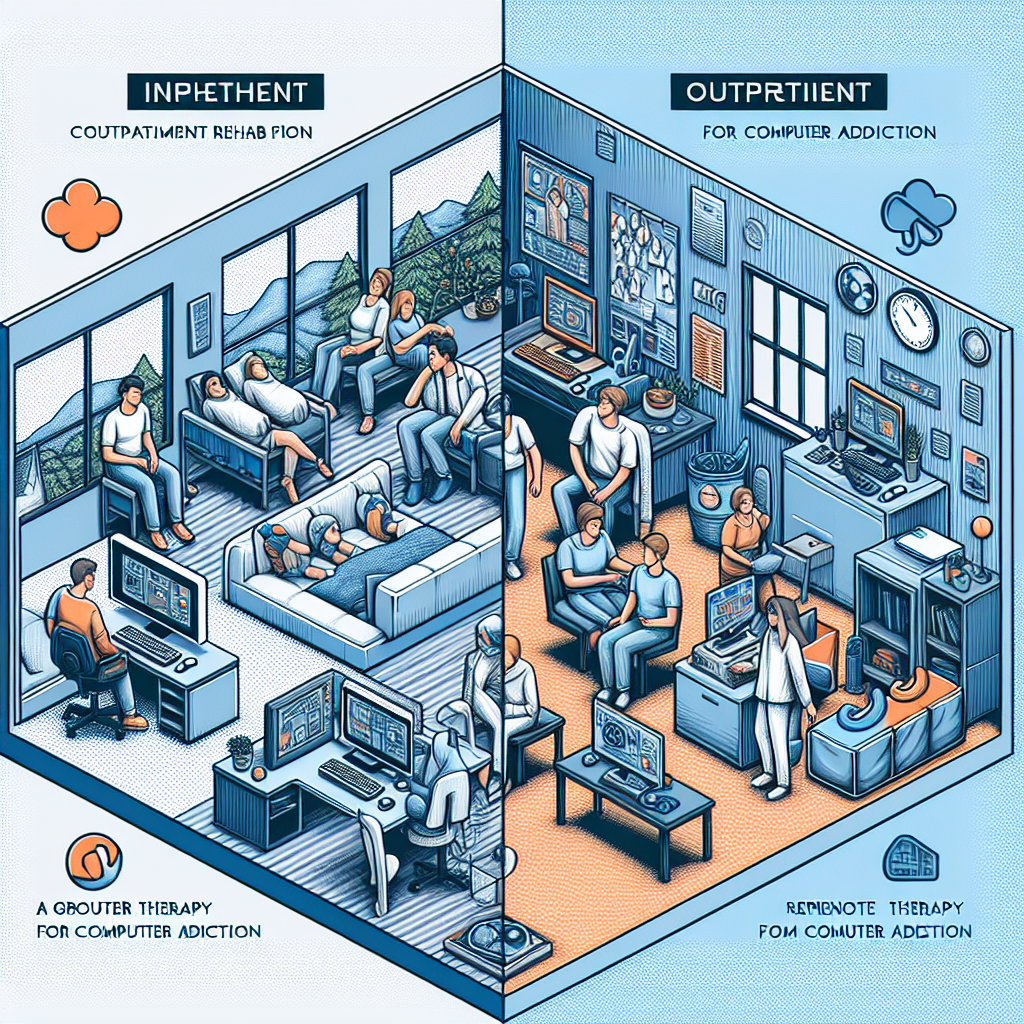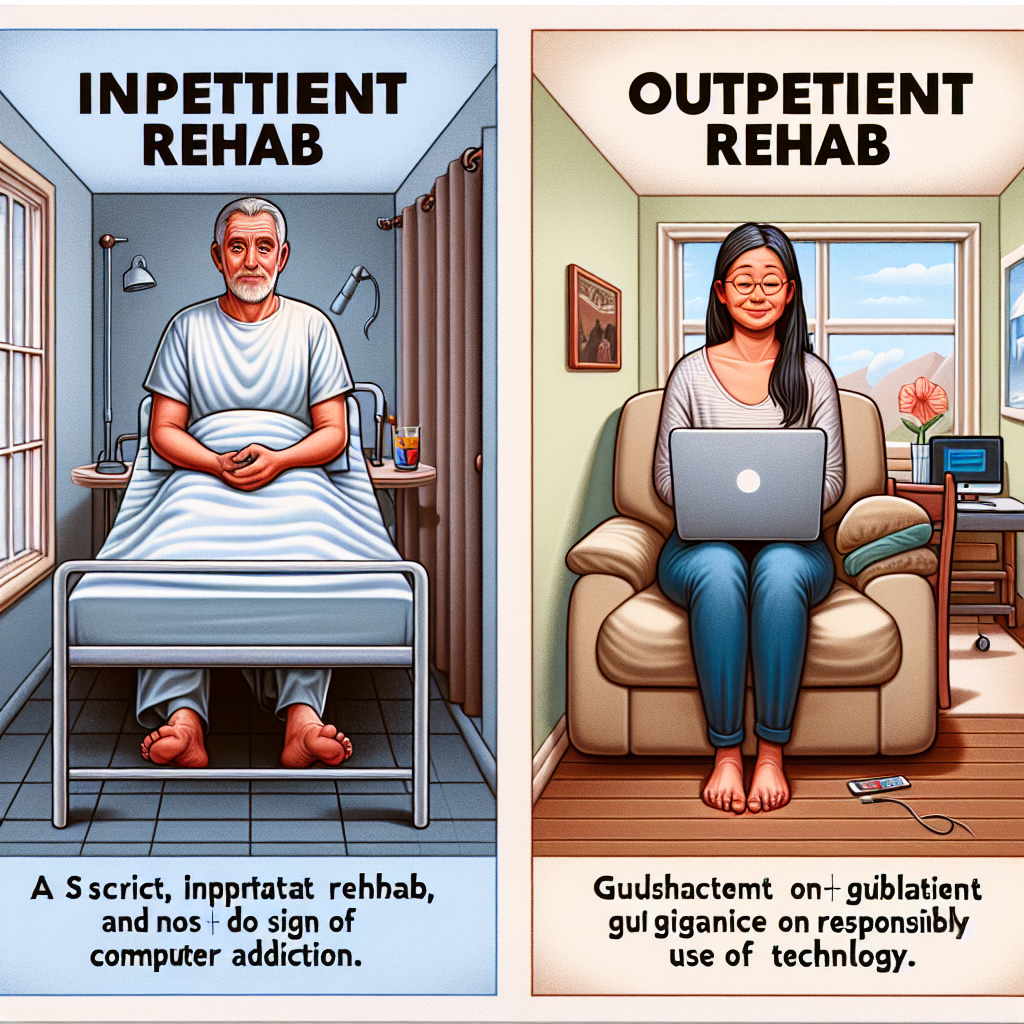-
Table of Contents

“Choosing the Right Path: Inpatient vs. Outpatient Rehab for Computer Addiction”
Introduction
In the realm of addressing computer addiction, the choice between inpatient and outpatient rehabilitation programs is pivotal. Inpatient rehab involves a residential stay at a treatment facility, providing an immersive environment free from external distractions and temptations. This setting allows for intensive therapy, constant supervision, and a structured routine, which can be crucial for individuals with severe addiction. Conversely, outpatient rehab offers flexibility, enabling individuals to receive treatment while maintaining their daily responsibilities such as work or school. This approach can be beneficial for those with milder addiction or strong support systems at home. Comparing these two modalities involves evaluating factors such as the severity of the addiction, the individual’s personal circumstances, and the level of support required to achieve and maintain recovery.
Benefits And Drawbacks Of Inpatient Rehab For Computer Addiction
Inpatient rehab for computer addiction offers a structured and immersive environment that can be highly beneficial for individuals struggling to break free from their dependency on digital devices. One of the primary advantages of inpatient rehab is the removal of external distractions and triggers. By residing in a controlled setting, patients are distanced from the very technology that fuels their addiction, allowing them to focus entirely on recovery. This separation can be particularly effective in the initial stages of treatment, where the temptation to relapse is at its highest.
Moreover, inpatient rehab provides round-the-clock support from a team of professionals, including therapists, counselors, and medical staff. This constant access to care ensures that patients receive immediate assistance during moments of crisis or when they experience intense cravings. The comprehensive nature of inpatient programs often includes a variety of therapeutic approaches, such as cognitive-behavioral therapy, group therapy, and individual counseling. These diverse methods work synergistically to address the underlying psychological issues contributing to the addiction, fostering a holistic recovery process.
Another significant benefit of inpatient rehab is the sense of community it fosters among patients. Sharing experiences and challenges with others who are facing similar struggles can be incredibly empowering. This camaraderie not only provides emotional support but also helps patients build a network of accountability, which can be crucial for long-term recovery. The structured daily routines and scheduled activities in inpatient rehab also instill a sense of discipline and purpose, which can be instrumental in helping individuals develop healthier habits and coping mechanisms.
However, inpatient rehab is not without its drawbacks. One of the most notable challenges is the cost. Inpatient programs can be expensive, and not all insurance plans cover the full extent of treatment. This financial burden can be a significant barrier for many individuals seeking help. Additionally, the time commitment required for inpatient rehab can be daunting. Patients often need to take a leave of absence from work or school, which can disrupt their personal and professional lives. This extended absence can also strain relationships with family and friends, adding another layer of complexity to the recovery process.
Furthermore, the transition from inpatient rehab back to everyday life can be challenging. The controlled environment of the rehab facility is vastly different from the outside world, where triggers and temptations are omnipresent. Without proper aftercare and support, individuals may find it difficult to maintain the progress they made during their stay. This is why many inpatient programs emphasize the importance of continued therapy and support groups post-discharge to help patients navigate the challenges of reintegration.
In conclusion, while inpatient rehab for computer addiction offers numerous benefits, including a distraction-free environment, comprehensive care, and a supportive community, it also comes with its own set of challenges. The high cost, time commitment, and potential difficulties in transitioning back to daily life are significant considerations. However, for those who can afford it and are willing to commit to the process, inpatient rehab can provide a solid foundation for overcoming computer addiction and embarking on a path to a healthier, more balanced life. The key is to weigh these benefits and drawbacks carefully and choose the treatment option that best aligns with one’s individual needs and circumstances.
Comparing Success Rates: Inpatient Vs. Outpatient Rehab For Computer Addiction
When it comes to addressing computer addiction, the choice between inpatient and outpatient rehabilitation programs can significantly impact the success rates of recovery. Understanding the nuances of each approach is crucial for individuals seeking to reclaim their lives from the grip of excessive computer use. Both inpatient and outpatient rehab programs offer unique advantages and challenges, and their effectiveness can vary depending on the individual’s specific circumstances and needs.
Inpatient rehabilitation programs, often referred to as residential treatment, require individuals to live at the treatment facility for a specified period. This immersive environment provides a structured and supportive setting, which can be particularly beneficial for those with severe computer addiction. The constant supervision and access to professional help ensure that individuals are less likely to relapse during the critical early stages of recovery. Moreover, the removal from everyday triggers and stressors allows patients to focus entirely on their rehabilitation, fostering a deeper level of introspection and personal growth.
On the other hand, outpatient rehabilitation programs offer a more flexible approach, allowing individuals to continue with their daily responsibilities while receiving treatment. This can be especially advantageous for those who cannot afford to take extended time off from work or family obligations. Outpatient programs typically involve scheduled therapy sessions, support groups, and educational workshops, providing a comprehensive support system without the need for residential stay. This approach can be highly effective for individuals with milder forms of computer addiction or those who have a strong support network at home.
Comparing the success rates of inpatient and outpatient rehab for computer addiction reveals some interesting insights. Inpatient programs often boast higher initial success rates due to the intensive nature of the treatment and the controlled environment. The immersive experience allows individuals to break free from their addictive behaviors more effectively, leading to significant improvements in a relatively short period. However, the transition back to everyday life can be challenging, and without proper aftercare and support, the risk of relapse remains.
Conversely, outpatient programs may have lower initial success rates compared to inpatient treatment, primarily because individuals are still exposed to the same environments and triggers that contributed to their addiction. However, the gradual integration of coping strategies and the ability to apply learned skills in real-time can lead to more sustainable long-term recovery. The ongoing support and flexibility of outpatient programs can help individuals build resilience and develop healthier habits over time.
Ultimately, the choice between inpatient and outpatient rehab for computer addiction should be based on a thorough assessment of the individual’s needs, severity of addiction, and personal circumstances. Both approaches have their merits, and a combination of the two may sometimes be the most effective strategy. For instance, an individual might start with an inpatient program to gain initial control over their addiction and then transition to an outpatient program for continued support and maintenance.
In conclusion, while inpatient rehab offers a more controlled and intensive environment conducive to immediate recovery, outpatient rehab provides the flexibility and ongoing support necessary for long-term success. The journey to overcoming computer addiction is deeply personal, and finding the right balance between these two approaches can inspire hope and pave the way for a healthier, more balanced life.
Q&A
1. **Question:** What are the primary differences in the treatment approach between inpatient and outpatient rehab for computer addiction?
**Answer:** Inpatient rehab for computer addiction typically involves a structured, immersive environment where patients stay at the facility and receive 24/7 support, intensive therapy, and a controlled setting to avoid triggers. Outpatient rehab allows patients to live at home and maintain daily responsibilities while attending scheduled therapy sessions and support groups, offering more flexibility but less intensive supervision.
2. **Question:** How does the duration of treatment typically differ between inpatient and outpatient rehab for computer addiction?
**Answer:** Inpatient rehab programs for computer addiction usually last from 30 to 90 days, providing a concentrated period of treatment. Outpatient rehab programs can vary widely in duration, often extending from several months to a year or more, depending on the individual’s progress and needs.
Conclusion
In comparing inpatient and outpatient rehab for computer addiction, it is evident that both approaches offer distinct advantages and cater to different needs. Inpatient rehab provides a structured environment with intensive, round-the-clock care, which can be crucial for individuals with severe addiction or those who lack a supportive home environment. This setting allows for a focused and immersive treatment experience, often incorporating a variety of therapeutic modalities and support systems. On the other hand, outpatient rehab offers greater flexibility, allowing individuals to maintain their daily responsibilities such as work or school while receiving treatment. This approach can be more cost-effective and less disruptive to one’s life, making it suitable for those with milder addiction or strong external support systems. Ultimately, the choice between inpatient and outpatient rehab should be based on the severity of the addiction, the individual’s personal circumstances, and the level of support they require to achieve and maintain recovery.



